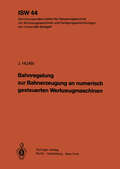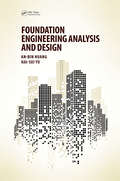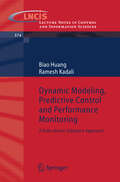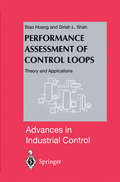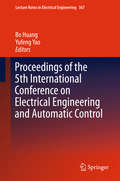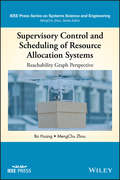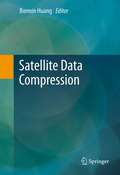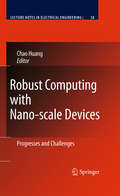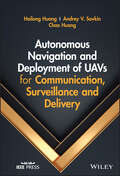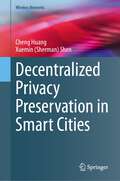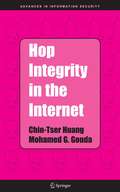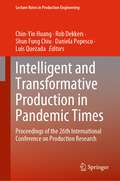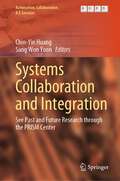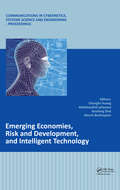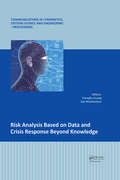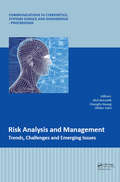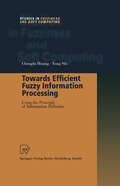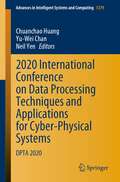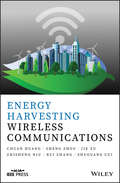- Table View
- List View
Bahnregelung zur Bahnerzeugung an numerisch gesteuerten Werkzeugmaschinen (ISW Forschung und Praxis #44)
by J. HuanFoundation Engineering Analysis and Design
by An-Bin Huang Hai-Sui YuOne of the core roles of a practising geotechnical engineer is to analyse and design foundations. This textbook for advanced undergraduates and graduate students covers the analysis, design and construction of shallow and deep foundations and retaining structures as well as the stability analysis and mitigation of slopes. It progressively introduces critical state soil mechanics and plasticity theories such as plastic limit analysis and cavity expansion theories before leading into the theories of foundation, lateral earth pressure and slope stability analysis. On the engineering side, the book introduces construction and testing methods used in current practice. Throughout it emphasizes the connection between theory and practice. It prepares readers for the more sophisticated non-linear elastic-plastic analysis in foundation engineering which is commonly used in engineering practice, and serves too as a reference book for practising engineers. A companion website provides a series of Excel spreadsheet programs to cover all examples included in the book, and PowerPoint lecture slides and a solutions manual for lecturers. Using Excel, the relationships between the input parameters and the design and analysis results can be seen. Numerical values of complex equations can be calculated quickly. non-linearity and optimization can be brought in more easily to employ functioned numerical methods. And sophisticated methods can be seen in practice, such as p-y curve for laterally loaded piles and flexible retaining structures, and methods of slices for slope stability analysis.
Foundation Engineering Analysis and Design
by An-Bin Huang Hai-Sui YuOne of the core roles of a practising geotechnical engineer is to analyse and design foundations. This textbook for advanced undergraduates and graduate students covers the analysis, design and construction of shallow and deep foundations and retaining structures as well as the stability analysis and mitigation of slopes. It progressively introduces critical state soil mechanics and plasticity theories such as plastic limit analysis and cavity expansion theories before leading into the theories of foundation, lateral earth pressure and slope stability analysis. On the engineering side, the book introduces construction and testing methods used in current practice. Throughout it emphasizes the connection between theory and practice. It prepares readers for the more sophisticated non-linear elastic-plastic analysis in foundation engineering which is commonly used in engineering practice, and serves too as a reference book for practising engineers. A companion website provides a series of Excel spreadsheet programs to cover all examples included in the book, and PowerPoint lecture slides and a solutions manual for lecturers. Using Excel, the relationships between the input parameters and the design and analysis results can be seen. Numerical values of complex equations can be calculated quickly. non-linearity and optimization can be brought in more easily to employ functioned numerical methods. And sophisticated methods can be seen in practice, such as p-y curve for laterally loaded piles and flexible retaining structures, and methods of slices for slope stability analysis.
Dynamic Modeling, Predictive Control and Performance Monitoring: A Data-driven Subspace Approach (Lecture Notes in Control and Information Sciences #Vol. 374)
by Biao Huang Ramesh KadaliA typical design procedure for model predictive control or control performance monitoring consists of: 1. identification of a parametric or nonparametric model; 2. derivation of the output predictor from the model; 3. design of the control law or calculation of performance indices according to the predictor. Both design problems need an explicit model form and both require this three-step design procedure. Can this design procedure be simplified? Can an explicit model be avoided? With these questions in mind, the authors eliminate the first and second step of the above design procedure, a “data-driven” approach in the sense that no traditional parametric models are used; hence, the intermediate subspace matrices, which are obtained from the process data and otherwise identified as a first step in the subspace identification methods, are used directly for the designs. Without using an explicit model, the design procedure is simplified and the modelling error caused by parameterization is eliminated.
Performance Assessment of Control Loops: Theory and Applications (Advances in Industrial Control)
by Biao Huang Sirish L. ShahThe series Advances in Industrial Control aims to report and encourage technology transfer in control engineering. The rapid development of control technology has an impact on all areas of the control discipline. New theory, new controllers, actuators, sensors, new industrial processes, computer methods, new applications, new philosophies. . . , new challenges. Much of this development work resides in industrial reports, feasibility study papers and the reports of advanced collaborative projects. The series offers an opportunity for researchers to present an extended exposition of such new work in all aspects of industrial control for widerand rapid dissemination. Benchmarking is a technique first applied by Rank Xerox in the late 1970s for business processes. As a subject in the commercial arena, benchmarking thrives with, for example, a European Benchmarking Forum. It has taken rather longer for benchmarking to make the transfer to the technical domain and even now the subject is making a slow headway. Akey research step in this direction was taken by Harris (1989) who used minimum variance control as a benchmark for controller loop assessment. This contribution opened up the area and a significant specialist literature has now developed. Significant support for the methodologywas given by Honeywell who have controller assessment routines in their process control applications software; therefore, it is timely to welcome a (first) monograph on controller performance assessment by Biao Huang and Sirish Shah to the Advances in Industrial Control series.
Plant-Environment Interactions
by Bingru HuangWith contributions from experts in various specialties, Plant-Environment Interactions discusses recent advances in cellular and molecular regulation of stress tolerance. This third edition reviews new research in stress signal perception, cellular mechanisms, and genetic manipulation of stress tolerance for each individual stress. It addresses how
Proceedings of the 5th International Conference on Electrical Engineering and Automatic Control (Lecture Notes in Electrical Engineering #367)
by Bo Huang Yufeng YaoOn the basis of instrument electrical and automatic control system, the 5th International Conference on Electrical Engineering and Automatic Control (CEEAC) was established at the crossroads of information technology and control technology, and seeks to effectively apply information technology to a sweeping trend that views control as the core of intelligent manufacturing and life. This book takes a look forward into advanced manufacturing development, an area shaped by intelligent manufacturing. It highlights the application and promotion of process control represented by traditional industries, such as the steel industry and petrochemical industry; the technical equipment and system cooperative control represented by robot technology and multi-axis CNC; and the control and support of emerging process technologies represented by laser melting and stacking, as well as the emerging industry represented by sustainable and intelligent life. The book places particular emphasis on the micro-segments field, such as intelligent micro-grids, new energy vehicles, and the Internet of Things.
Supervisory Control and Scheduling of Resource Allocation Systems: Reachability Graph Perspective (IEEE Press Series on Systems Science and Engineering)
by Bo Huang MengChu ZhouPresents strategies with reachability graph analysis for optimizing resource allocation systems Supervisory Control and Scheduling of Resource Allocation Systems offers an important guide to Petri net (PN) models and methods for supervisory control and system scheduling of resource allocation systems (RASs). Resource allocation systems are common in automated manufacturing systems, project management systems, cloud data centers, and software engineering systems. The authors—two experts on the topic—present a definition, techniques, models, and state-of-the art applications of supervisory control and scheduling problems. The book introduces the basic concepts and research background on resource allocation systems and Petri nets. The authors then focus on the deadlock-free supervisor synthesis for RASs using Petri nets. The book also investigates the heuristic scheduling of RASs based on timed Petri nets. Conclusions and open problems are provided in the last section of the book. This important book: Includes multiple methods for supervisory control and scheduling with reachability graphs, and provides illustrative examples Reveals how to accelerate the supervisory controller design and system scheduling of RASs based on PN reachability graphs, with optimal or near-optimal results Highlights both solution quality and computational speed in RAS deadlock handling and system scheduling Written for researchers, engineers, scientists, and professionals in system planning and control, engineering, operation, and management, Supervisory Control and Scheduling of Resource Allocation Systems provides an essential guide to the supervisory control and scheduling of resource allocation systems (RASs) using Petri net reachability graphs, which allow for multiple resource acquisitions and flexible routings.
Supervisory Control and Scheduling of Resource Allocation Systems: Reachability Graph Perspective (IEEE Press Series on Systems Science and Engineering)
by Bo Huang MengChu ZhouPresents strategies with reachability graph analysis for optimizing resource allocation systems Supervisory Control and Scheduling of Resource Allocation Systems offers an important guide to Petri net (PN) models and methods for supervisory control and system scheduling of resource allocation systems (RASs). Resource allocation systems are common in automated manufacturing systems, project management systems, cloud data centers, and software engineering systems. The authors—two experts on the topic—present a definition, techniques, models, and state-of-the art applications of supervisory control and scheduling problems. The book introduces the basic concepts and research background on resource allocation systems and Petri nets. The authors then focus on the deadlock-free supervisor synthesis for RASs using Petri nets. The book also investigates the heuristic scheduling of RASs based on timed Petri nets. Conclusions and open problems are provided in the last section of the book. This important book: Includes multiple methods for supervisory control and scheduling with reachability graphs, and provides illustrative examples Reveals how to accelerate the supervisory controller design and system scheduling of RASs based on PN reachability graphs, with optimal or near-optimal results Highlights both solution quality and computational speed in RAS deadlock handling and system scheduling Written for researchers, engineers, scientists, and professionals in system planning and control, engineering, operation, and management, Supervisory Control and Scheduling of Resource Allocation Systems provides an essential guide to the supervisory control and scheduling of resource allocation systems (RASs) using Petri net reachability graphs, which allow for multiple resource acquisitions and flexible routings.
Satellite Data Compression: 31 July-1 August, 2005, San Diego, California, Usa (Proceedings Of Spie Ser. #5889)
by Bormin HuangSatellite Data Compression covers recent progress in compression techniques for multispectral, hyperspectral and ultra spectral data. A survey of recent advances in the fields of satellite communications, remote sensing and geographical information systems is included. Satellite Data Compression, contributed by leaders in this field, is the first book available on satellite data compression. It covers onboard compression methodology and hardware developments in several space agencies. Case studies are presented on recent advances in satellite data compression techniques via various prediction-based, lookup-table-based, transform-based, clustering-based, and projection-based approaches. This book provides valuable information on state-of-the-art satellite data compression technologies for professionals and students who are interested in this topic. Satellite Data Compression is designed for a professional audience comprised of computer scientists working in satellite communications, sensor system design, remote sensing, data receiving, airborne imaging and geographical information systems (GIS). Advanced-level students and academic researchers will also benefit from this book.
Robust Computing with Nano-scale Devices: Progresses and Challenges (Lecture Notes in Electrical Engineering #58)
by Chao HuangRobust Nano-Computing focuses on various issues of robust nano-computing, defect-tolerance design for nano-technology at different design abstraction levels. It addresses both redundancy- and configuration-based methods as well as fault detecting techniques through the development of accurate computation models and tools. The contents present an insightful view of the ongoing researches on nano-electronic devices, circuits, architectures, and design methods, as well as provide promising directions for future research.
Autonomous Navigation and Deployment of UAVs for Communication, Surveillance and Delivery
by Chao Huang Hailong Huang Andrey V. SavkinAutonomous Navigation and Deployment of UAVs for Communication, Surveillance and Delivery Authoritative resource offering coverage of communication, surveillance, and delivery problems for teams of unmanned aerial vehicles (UAVs) Autonomous Navigation and Deployment of UAVs for Communication, Surveillance and Delivery studies various elements of deployment of networks of unmanned aerial vehicle (UAV) base stations for providing communication to ground users in disaster areas, covering problems like ground traffic monitoring, surveillance of environmental disaster areas (e.g. brush fires), using UAVs in rescue missions, converting UAV video surveillance, and more. The work combines practical problems, implementable and computationally efficient algorithms to solve these problems, and mathematically rigorous proofs of each algorithm’s convergence and performance. One such example provided by the authors is a novel biologically inspired motion camouflage algorithm to covert video surveillance of moving targets by an unmanned aerial vehicle (UAV). All autonomous navigation and deployment algorithms developed in the book are computationally efficient, easily implementable in engineering practice, and based only on limited information on other UAVs of each and the environment. Sample topics discussed in the work include: Deployment of UAV base stations for communication, especially with regards to maximizing coverage and minimizing interference Deployment of UAVs for surveillance of ground areas and targets, including surveillance of both flat and uneven areas Navigation of UAVs for surveillance of moving areas and targets, including disaster areas and ground traffic monitoring Autonomous UAV navigation for covert video surveillance, offering extensive coverage of optimization-based navigation Integration of UAVs and public transportation vehicles for parcel delivery, covering both one-way and round trips Professionals in navigation and deployment of unmanned aerial vehicles, along with researchers, engineers, scientists in intersecting fields, can use Autonomous Navigation and Deployment of UAVs for Communication, Surveillance and Delivery to gain general knowledge on the subject along with practical, precise, and proven algorithms that can be deployed in a myriad of practical situations.
Autonomous Navigation and Deployment of UAVs for Communication, Surveillance and Delivery
by Chao Huang Hailong Huang Andrey V. SavkinAutonomous Navigation and Deployment of UAVs for Communication, Surveillance and Delivery Authoritative resource offering coverage of communication, surveillance, and delivery problems for teams of unmanned aerial vehicles (UAVs) Autonomous Navigation and Deployment of UAVs for Communication, Surveillance and Delivery studies various elements of deployment of networks of unmanned aerial vehicle (UAV) base stations for providing communication to ground users in disaster areas, covering problems like ground traffic monitoring, surveillance of environmental disaster areas (e.g. brush fires), using UAVs in rescue missions, converting UAV video surveillance, and more. The work combines practical problems, implementable and computationally efficient algorithms to solve these problems, and mathematically rigorous proofs of each algorithm’s convergence and performance. One such example provided by the authors is a novel biologically inspired motion camouflage algorithm to covert video surveillance of moving targets by an unmanned aerial vehicle (UAV). All autonomous navigation and deployment algorithms developed in the book are computationally efficient, easily implementable in engineering practice, and based only on limited information on other UAVs of each and the environment. Sample topics discussed in the work include: Deployment of UAV base stations for communication, especially with regards to maximizing coverage and minimizing interference Deployment of UAVs for surveillance of ground areas and targets, including surveillance of both flat and uneven areas Navigation of UAVs for surveillance of moving areas and targets, including disaster areas and ground traffic monitoring Autonomous UAV navigation for covert video surveillance, offering extensive coverage of optimization-based navigation Integration of UAVs and public transportation vehicles for parcel delivery, covering both one-way and round trips Professionals in navigation and deployment of unmanned aerial vehicles, along with researchers, engineers, scientists in intersecting fields, can use Autonomous Navigation and Deployment of UAVs for Communication, Surveillance and Delivery to gain general knowledge on the subject along with practical, precise, and proven algorithms that can be deployed in a myriad of practical situations.
Decentralized Privacy Preservation in Smart Cities (Wireless Networks)
by Cheng Huang Xuemin (Sherman) ShenThis book investigates decentralized trust-based privacy-preserving solutions in smart cities. The authors first present an overview of smart cities and privacy challenges and discuss the benefits of adopting decentralized trust models in achieving privacy preservation. The authors then give a comprehensive review of fundamental decentralized techniques and privacy-preserving cryptographic techniques. The next four chapters each detail a decentralized trust-based scheme, focusing respectively on privacy-preserving identity management, cross-domain authentication, data analytics, and data search, in specific use cases. Finally, the book explores open issues and outlines future research directions in the field of decentralized privacy preservation.
Hop Integrity in the Internet (Advances in Information Security #21)
by Chin-Tser Huang Mohamed G. GoudaDenial-of-service attacks are one of the most severe challenges confronting the online world. This ground-breaking volume discusses a new method of countering denial-of-service attacks called hop integrity. It details a suite of protocols for providing hop integrity. In particular, each protocol in this suite is specified and verified using an abstract and formal notation, called the Secure Protocol Notation. In addition, the book presents an alternative way to achieve strong hop integrity with hard sequence numbers.
Intelligent and Transformative Production in Pandemic Times: Proceedings of the 26th International Conference on Production Research (Lecture Notes in Production Engineering)
by Chin-Yin Huang Rob Dekkers Shun Fung Chiu Daniela Popescu Luis QuezadaThis book contains the proceeding of the 26th International Conference on Production Research (ICPR). ICPR is a biennial conference that has been hosted for more than a half century. It is regarded worldwide as one of the leading conferences of production research, industrial engineering, and related subjects. The acute impact of the pandemic on human lives is spurring further research and advances: because modern life relies on production and supply networks. The future of production calls for transformative research exploiting the possibilities of artificial intelligence in particular to respond to the challenge of sustainability. This book is of interest to researchers, students, and professionals in industry.
Systems Collaboration and Integration: See Past and Future Research through the PRISM Center (Automation, Collaboration, & E-Services #14)
by Chin-Yin Huang Sang Won YoonThis book is a groundbreaking exploration of the historical and contemporary challenges in systems collaboration and integration. This exceptional book delves into engineering design, planning, control, and management, offering invaluable insights into the evolving nature of systems and networks. In an era defined by the ongoing cyber and digital transformation, coupled with artificial intelligence and machine learning, this book offers insights into the future of systems collaboration and integration. Over the past three decades, the PRISM Center and its affiliated PRISM Global Research Network (PGRN) have spearheaded pioneering theories, technologies, and applications in the realm of systems collaboration and integration. Their research, driven by the motto “Knowledge through information; Wisdom through collaboration,” has yielded remarkable advancements. Those achievements and papers presented and updated by the PGRN scholars in the 26th ICPR are included in this book.
Emerging Economies, Risk and Development, and Intelligent Technology: Proceedings of the 5th International Conference on Risk Analysis and Crisis Response, June 1-3, 2015, Tangier, Morocco
by Chongfu Huang Abdelouahid Lyhyaoui Zhai Guofang Nesrin BenhayounRACR is a series of biennial international conferences on risk analysis, crisis response, and disaster prevention for specialists and stakeholders. RACR-2015, held June 1-3, 2015 in Tangier, Morocco, was the fifth conference in this series, following the successful RACR-2007 in Shanghai (China), RACR-2009 in Beijing (China), RACR-2011 in Laredo (US
Risk Analysis Based on Data and Crisis Response Beyond Knowledge: Proceedings of the 7th International Conference on Risk Analysis and Crisis Response (RACR 2019), October 15-19, 2019, Athens, Greece
by Chongfu Huang Zoe S. NivolianitouThis book collects the papers presented at the 7th International Conference on Risk Analysis and Crisis Response (RACR-2019) held in Athens, Greece, on October 15-19, 2019. The overall theme of the seventh international conference on risk analysis and crisis response is Risk Analysis Based on Data and Crisis Response Beyond Knowledge, highlighting science and technology to improve risk analysis capabilities and to optimize crisis response strategy. This book contains primarily research articles of risk issues. Underlying topics include natural hazards and major (chemical) accidents prevention, disaster risk reduction and society resilience, information and communication technologies safety and cybersecurity, modern trends in crisis management, energy and resources security, critical infrastructure, nanotechnology safety and others. All topics include aspects of multidisciplinarity and complexity of safety in education and research. The book should be valuable to professors, engineers, officials, businessmen and graduate students in risk analysis and risk management.
Risk Analysis Based on Data and Crisis Response Beyond Knowledge: Proceedings of the 7th International Conference on Risk Analysis and Crisis Response (RACR 2019), October 15-19, 2019, Athens, Greece
by Chongfu Huang Zoe S. NivolianitouThis book collects the papers presented at the 7th International Conference on Risk Analysis and Crisis Response (RACR-2019) held in Athens, Greece, on October 15-19, 2019. The overall theme of the seventh international conference on risk analysis and crisis response is Risk Analysis Based on Data and Crisis Response Beyond Knowledge, highlighting science and technology to improve risk analysis capabilities and to optimize crisis response strategy. This book contains primarily research articles of risk issues. Underlying topics include natural hazards and major (chemical) accidents prevention, disaster risk reduction and society resilience, information and communication technologies safety and cybersecurity, modern trends in crisis management, energy and resources security, critical infrastructure, nanotechnology safety and others. All topics include aspects of multidisciplinarity and complexity of safety in education and research. The book should be valuable to professors, engineers, officials, businessmen and graduate students in risk analysis and risk management.
Risk Analysis and Management - Trends, Challenges and Emerging Issues: Proceedings of the 6th International Conference on Risk Analysis and Crisis Response (RACR 2017), June 5-9, 2017, Ostrava, Czech Republic
by Chongfu Huang Olivier Salvi Aleš BernatikThis book collects the papers presented at the 6th International Conference on Risk Analysis and Crisis Response (RACR-2017) held in Ostrava/Prague, Czech Republic, on June 5-9, 2017, organized by VSB-Technical University of Ostrava, Czech Republic. The overall theme of the sixth international conference on risk analysis and crisis response is Risk Analysis and Management – Trends, Challenges and Emerging Issues, highlighting science and technology to improve risk analysis capabilities and to optimize crisis response strategy.This book contains primarily research articles of risk issues. Underlying topics include natural hazards and major (chemical) accidents prevention, disaster risk reduction and society resilience, information and communication technologies safety and cybersecurity, modern trends in crisis management, energy and resources security, critical infrastructure, nanotechnology safety and others. All topics include aspects of multidisciplinarity and complexity of safety in education and research. The book should be valuable to professors, engineers, officials, businessmen and graduate students in risk analysis and risk management. About the book series Communications in Cybernetics, Systems Science and Engineering - Proceedings (CCSSEP) is a cross-disciplinary book series devoted to theoretical and applied research contributions, that cater to a rapidly growing worldwide interest in a cybernetic and systemic methodology with an ever-increasing capacity to deal with new challenges in a way that traditional science cannot. The series aims to become a comprehensive reference work on and guide to developments within the field and strategies required for better implementation of advances, with a view to environmental protection and sustainable social and economic development. The CCSSE series targets all working in theoretical and applied fields of cybernetics, systems science and engineering, e.g. academics, researchers and consultants, computer and information scientists, development and systems engineers, mathematicians, management cyberneticists and systemists, medical scientists, and intelligent and manufacturing engineers in industry, as well as leading decision- and policy-makers. Series editor: Jeffrey ‘Yi-Lin’ Forrest
Towards Efficient Fuzzy Information Processing: Using the Principle of Information Diffusion (Studies in Fuzziness and Soft Computing #99)
by Chongfu Huang Yong ShiWhen we learn from books or daily experience, we make associations and draw inferences on the basis of information that is insufficient for under standing. One example of insufficient information may be a small sample derived from observing experiments. With this perspective, the need for de veloping a better understanding of the behavior of a small sample presents a problem that is far beyond purely academic importance. During the past 15 years considerable progress has been achieved in the study of this issue in China. One distinguished result is the principle of in formation diffusion. According to this principle, it is possible to partly fill gaps caused by incomplete information by changing crisp observations into fuzzy sets so that one can improve the recognition of relationships between input and output. The principle of information diffusion has been proven suc cessful for the estimation of a probability density function. Many successful applications reflect the advantages of this new approach. It also supports an argument that fuzzy set theory can be used not only in "soft" science where some subjective adjustment is necessary, but also in "hard" science where all data are recorded.
2020 International Conference on Data Processing Techniques and Applications for Cyber-Physical Systems: DPTA 2020 (Advances in Intelligent Systems and Computing #1379)
by Chuanchao Huang Yu-Wei Chan Neil YenThis book covers cutting-edge and advanced research on data processing techniques and applications for cyber-physical systems, gathering the proceedings of the International Conference on Data Processing Techniques and Applications for Cyber-Physical Systems (DPTA 2020), held in Laibin City, Guangxi Province, China, on December 11–12, 2020. It examines a wide range of topics, including distributed processing for sensor data in CPS networks; approximate reasoning and pattern recognition for CPS networks; data platforms for efficient integration with CPS networks; machine learning algorithms for CPS networks; and data security and privacy in CPS networks. Outlining promising future research directions, the book offers a valuable resource for students, researchers, and professionals alike, while also providing a useful reference guide for newcomers to the field.
Energy Harvesting Wireless Communications (Wiley - IEEE)
by Chuang Huang Sheng Zhou Jie Xu Zhisheng Niu Rui Zhang Shuguang CuiEnergy Harvesting Wireless Communications offers a review of the most current research as well as the basic concepts, key ideas and powerful tools of energy harvesting wireless communications. Energy harvesting is both renewable and cheap and has the potential for many applications in future wireless communication systems to power transceivers by utilizing environmental energy such as solar, thermal, wind, and kinetic energy. The authors—noted experts in the field—explore the power allocation for point-to-point energy harvesting channels, power allocation for multi-node energy harvesting channels, and cross-layer design for energy harvesting links. In addition, they offer an in-depth examination of energy harvesting network optimization and cover topics such as energy harvesting ad hoc networks, cost aware design for energy harvesting assisted cellular networks, and energy harvesting in next generation cellular networks.
Energy Harvesting Wireless Communications (Wiley - IEEE)
by Chuang Huang Sheng Zhou Jie Xu Zhisheng Niu Rui Zhang Shuguang CuiEnergy Harvesting Wireless Communications offers a review of the most current research as well as the basic concepts, key ideas and powerful tools of energy harvesting wireless communications. Energy harvesting is both renewable and cheap and has the potential for many applications in future wireless communication systems to power transceivers by utilizing environmental energy such as solar, thermal, wind, and kinetic energy. The authors—noted experts in the field—explore the power allocation for point-to-point energy harvesting channels, power allocation for multi-node energy harvesting channels, and cross-layer design for energy harvesting links. In addition, they offer an in-depth examination of energy harvesting network optimization and cover topics such as energy harvesting ad hoc networks, cost aware design for energy harvesting assisted cellular networks, and energy harvesting in next generation cellular networks.
